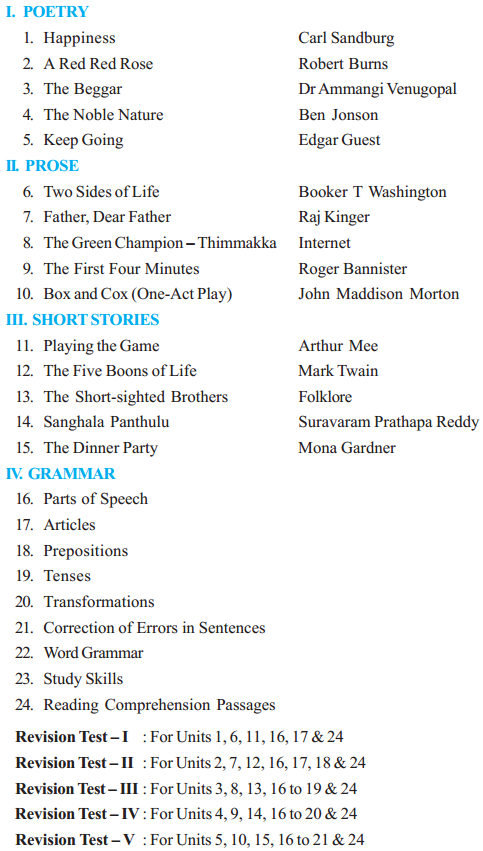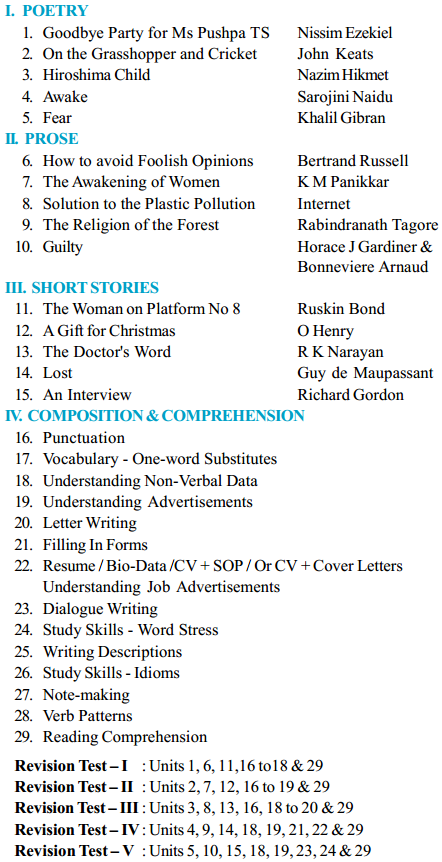TS Intermediate 2nd Year Economics Study Material Textbook Solutions Telangana
TS Inter 2nd Year Economics Study Material in Telugu Medium
TS Inter 2nd Year Economics Study Material in English Medium
TS Inter 2nd Year Economics Syllabus
Telangana TS Intermediate 2nd Year Economics Syllabus
Unit 1 Economic Growth and Economic Development (14 Periods)
Concepts of Economic Growth and Economic Development: Distinction between Growth and Development, Objectives of Economic Development, Indicators of Economic Development, Factors Hindering Economic Development, Factors Promoting Economic Development, Characteristics of Developed Economies, Characteristics of Developing Economies with special reference to India.
Unit 2 Demography and Human Resource Development (16 Periods)
Theory of Demographic Transition, Demographic Features of Indian Population, Concept & Causes of Population Explosion, Occupational Distribution of Population of India, Sectoral Distribution of Population of India, Population Policies in India, Concept of Human Resource Development, Human Development Index (HDI), Role of Education and Health in Economic Development, Views of Amartya Sen on Human Development.
Unit 3 National Income, Poverty & Unemployment (25 Periods)
Trends in National Income and Per Capita Income in India, Sectoral Contribution to National Income, Share of Public and Private Sectors in GDP, Inequalities in the Distribution of Income and Wealth, Poverty in India: Concept, Causes & Consequences, Unemployment in India: Concept, Causes & Consequences, Remedial Measures of Poverty & Unemployment and Government Initiatives, Views of Abhijit Banerjee on Poverty.
Unit 4 Planning and NITI Aayog (20 Periods)
Concept, Types & Importance of Planning, Major Objectives of Five Year Plans in India, Review of Five Year Plans, NITI Aayog, Rural-Urban Imbalances, Regional Imbalances: Causes, Consequences & Remedial Measures.
Unit 5 Agricultural Sector (30 Periods)
Importance & Growth of Agriculture in the Indian Economy, Causes for Low Productivity in Agriculture, Measures to Improve Agricultural Productivity in India, Land Reforms in India, Green Revolution Agricultural Credit & Rural Indebtedness, Agricultural Marketing in India, Agricultural Pricing in India, Food, Food Security in India.
Unit 6 Industrial Sector (20 Periods)
Structure of Indian Industry, Growth and Pattern of Industrial Development in India, Industrial Policy Resolutions and Economic Reforms, Role of Small Scale Industries in Indian Economy, Problems & Remedial Measures of Small Scale Industries, Industrial Finance.
Unit 7 Tertiary Sector (12 Periods)
Importance of Tertiary Sector in India, Infrastructural Development in India, Transport, Energy, Communication and Information Technology, Space Sector, Banking & Insurance, Tourism.
Unit 8 Foreign Sector (15 Periods)
Balance of Trade & Balance of Payments, Role of International Trade in India Economy, FDI, WTO: Its Impact on Indian Economy.
Unit 9 Environmental Economics (14 Periods)
Concept, Types, and Importance of Environment, Concepts of Eco-System, Pollution and Environmental Degradation, Natural Resources, Need for Environmental Protection, and Sustainable Development.
Unit 10 Telangana Economy (14 Periods)
Structure of Telangana, Gross State Domestic Product (GSDP) Trends, Sectorial Contribution, and Per Capita Income, Demographic Features of Telangana, Agricultural Sector, Industrial Sector, and Tertiary Sector, Infrastructural Development with special reference to Irrigation, Energy, Health and Education, Poverty and Unemployment in Telangana, Development and Welfare Progarammes in Telangana State.
TS Inter 2nd Year Economics Syllabus in Telugu
యూనిట్ 1 ఆర్థిక వృద్ధి, ఆర్థికాభివృద్ధి
ఆర్థిక వృద్ధి, ఆర్థికాభివృద్ధి భావనలు – ఆర్థిక వృద్ధి, ఆర్థికాభివృద్ధిల మధ్య తారతమ్యాలు – ఆర్థికాభివృద్ధి లక్ష్యాలు – ఆర్థికాభివృద్ధి సూచనలు – ఆర్థికాభివృద్ధి నిరోధకాలు / అవరోధాలు – ఆర్థికాభివృద్ధిని ప్రోత్సహించే కారకాలు అభివృద్ధి చెందిన ఆర్థిక వ్యవస్థల లక్షణాలు’ – భారతదేశం వంటి అభివృద్ధి చెందుతున్న దేశాల లక్షణాలు.
యూనిట్ 2 జనాభా, మానవ వనరుల అభివృద్ధి
జనాభా పరిణామ సిద్ధాంతం – భారతదేశం జనాభా లక్షణాలు జనాభా విస్ఫోటనం భావన, కారణాలు – భారతదేశంలో వృత్తులవరీ జనాభా విభజన – భారతదేశంలో రంగాల వారీ జనాభా విభజన – భారతదేశంలో జనాభా విధానాలు – మానవ వనరుల అభివృద్ధి భావన – మానవ అభివృద్ధి సూచిక – ఆర్థికాభివృద్ధిలో విద్య, ఆరోగ్యం పాత్ర – మానవ అభివృద్ధిపై అమర్త్యసేన్ ఆలోచనలు.
యూనిట్ 3 జాతీయాదాయం, పేదరికం, నిరుద్యోగిత
భారతదేశంలో జాతీయాదాయం, తలసరి ఆదాయ ధోరణులు – జాతీయాదాయంలో వివిధ రంగాల వాటా – స్థూల దేశీయోత్పత్తిలో ప్రభుత్వ, ప్రైవేటు రంగాల వాటా – ఆదాయం, పర్యవసానాలు – భారతదేశంలో నిరుద్యోగిత భావన, కారణాలు, పర్యవసానాలు, పేదరికం, నిరుద్యోగితల నివారణ చర్యలు – ప్రభుత్వ కార్యక్రమాలు – పేదరికం పట్ల అభిజిత్ బెనర్జీ అభిప్రాయాలు.
యూనిట్ 4 ప్రణాళికలు, నీతి ఆయోగ్
ప్రణాళికల భావన, రకాలు, ప్రాధాన్యత – భారతదేశంలలో పంచవర్ష ప్రణాళికల ప్రధాన లక్ష్యాలు, పంచవర్ష ప్రణాళఙ్ఞకల సమీక్ష – భారతదేశ పరివర్తన కోసం జాతాయ సంస్థ లేదా నీతి ఆయోగ్, గ్రామీణ, పట్టణ ప్రాంతాల మధ్య అసమానతలు – ప్రాంతీయ అసమానతలు : కారణాలు, పర్యవసానాలు నివారణ చర్యలు.
యూనిట్ 5 వ్యవసాయ రంగం
భారతదేశ ఆర్థిక వ్యవస్థలో వ్యవసాయ ప్రాధాన్యత, వృద్ధి – వ్యవసాయంలో అల్ప ఉత్పాదకతకు కారణాలు – భారతదేశంలో వ్యవసాయ ఉత్పాదకతను పెంచే చర్యలు – భారతదేశంలో భూసంస్కరణలు – హరిత విప్లవం – వ్యవసాయ పరపతి గ్రామీణ రుణ గ్రస్తత – భారతదేశంలో వ్యవసాయ మార్కెటింగ్ – భారతదేశంలో వ్యవసాయ ధరల విధానం – ఆహార భద్రత.
యూనిట్ 6 పారిశ్రామిక రంగం
భారత పారిశ్రామిక నిర్మాణం – భారతదేశంలో పారిశ్రామికాభివృద్ధి – ధోరణి – పారిశ్రామిక విధాన తీర్మానాలు, ఆర్థిక సంస్కరణలు – భారతదేశ ఆర్థిక వ్యవస్థలో చిన్న తరహా పరిశ్రమల పాత్ర – చిన్న తరహా పరిశ్రమల సమస్యలు, నివారణ చర్యలు పారిశ్రామిక విత్తం.
యూనిట్ 7 తృతీయ రంగం
భారతదేశంలో తృతీయ రంగం ప్రాముఖ్యత – భారతదేశంలో అవస్థాపనా రంగ అభివృద్ధి – రవాణా రంగం – ఇంధన (శక్తి) రంగం – సమాచార రంగం, ఇన్ఫర్మేషన్ టెక్నాలజీ – అంతరిక్ష రంగం – బ్యాంకింగ్, బీమా రంగం – పర్యాటక రంగం.
యూనిట్ 8 విదేశీ రంగం
విదేశీ వర్తక మిగులు, విదేశీ వర్తక చెల్లింపుల శేషం – భారతదేశ ఆర్థిక వ్యవస్థలో అంతర్జాతీయ వర్తకపు పాత్ర – విదేశీ ప్రత్యక్ష పెట్టుబడి – ప్రపంచ వర్తక సంస్థ (WTO) : భారతదేశంపై దాని ప్రభావం.
యూనిట్ 9 పర్యావరణ అర్థశాస్త్రం
పర్యావరణం భావన, రకాలు, ప్రాధాన్యత – ఆవరణ వ్యవస్థ, కాలుష్యం, పర్యావరణ విచ్ఛేదన భావనలు – సహజ వనరులు – పర్యావరణ పరిరక్షణ ఆవశ్యకత – సుస్థిర అభివృద్ధి.
యూనిట్ 10 తెలంగాణ ఆర్థిక వ్యవస్థ
తెలంగాణ రాష్ట్ర నిర్మాణం – స్థూల రాష్ట్ర ప్రాంతీయోత్పత్తి ధోరణులు – రంగాల వాటి తలసరి ఆదాయం – తెలంగాణ జనాభా లక్షణాలు – వ్యవసాయ రంగం, పారిశ్రామిక రంగం, తృతీయ రంగం – అవస్థాపనా సౌకర్యాల అభివృద్ధి నీటిపారుదల ఇంధనం, ఆరోగ్యం, విద్య – తెలంగాణలో పేదరికం, నిరుద్యోగిత – తెలంగాణ రాష్ట్రంలో అభివృద్ధి, సంక్షేమ పథకాలు.

